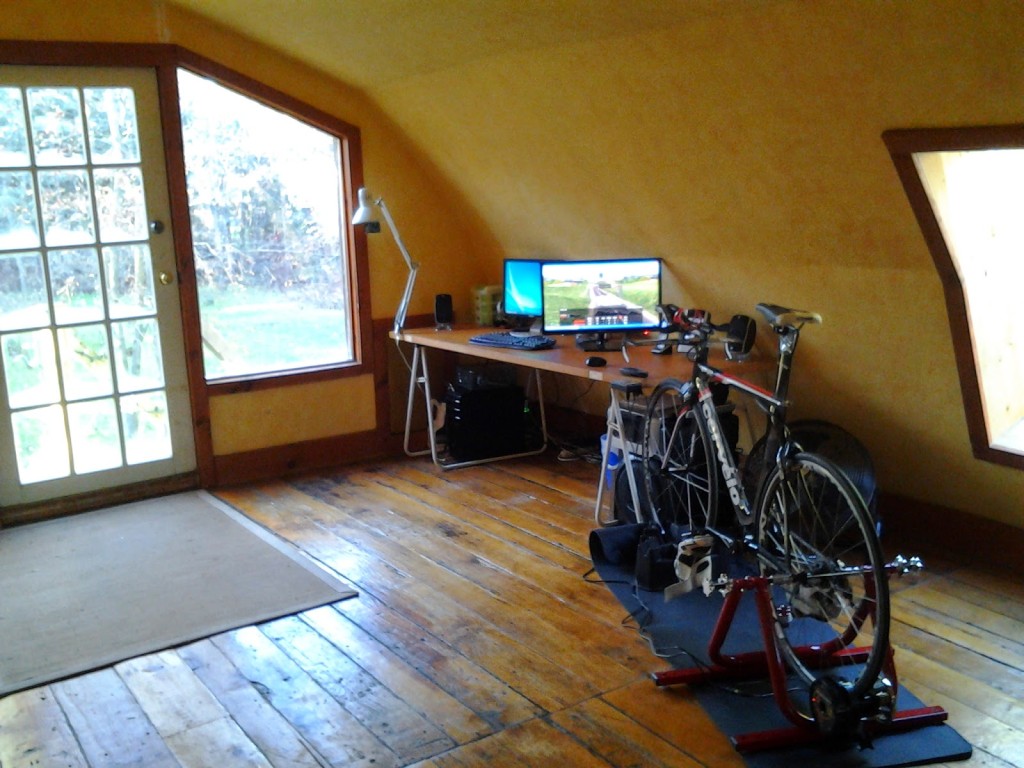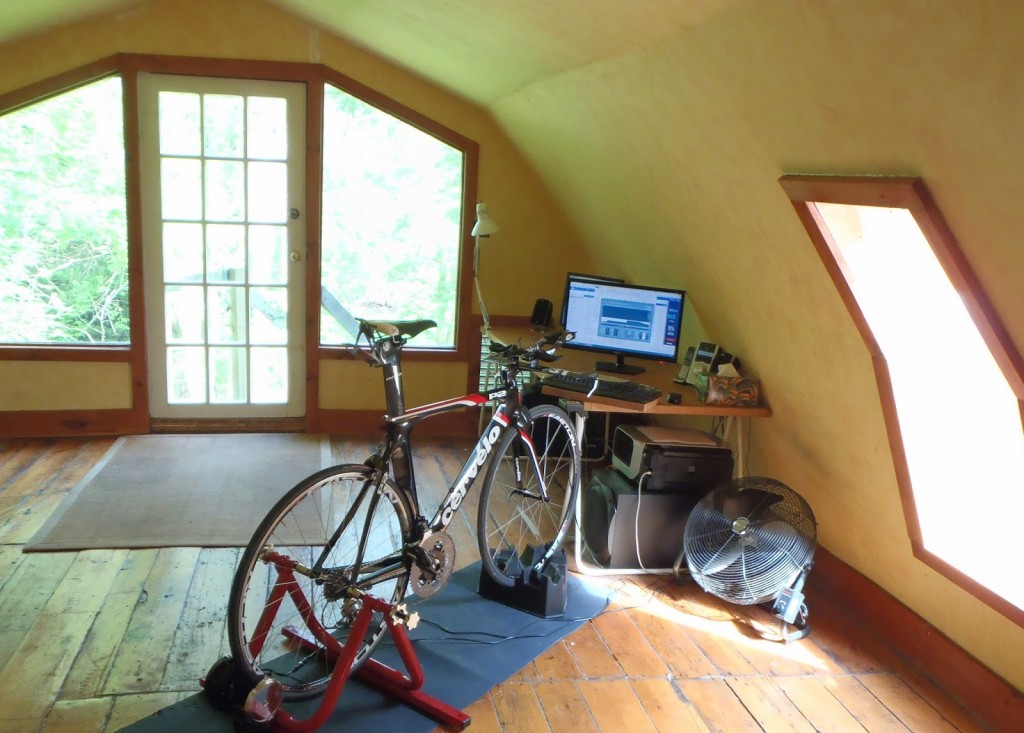Four months. Four sweaty, solitary, strenuous months on the CompuTrainer, courtesy of the polar vortex. That’s how.
The never-ending winter forced me to cycle exclusively on the CompuTrainer from November until the week of Texas 70.3 in April, my first race of the season and my pro debut. At first, I saw it as a setback, but I later realized that it was my secret weapon.
In 2012, cycling was my weakest triathlon discipline by a long shot. I lost minutes to stronger cyclists every race and never broke an hour for 40km/25mi. The 2013 season brought some improvement, but gains came slowly and I was still out of my element on the bike.
Fast-forward less than two years and I rode one of the fastest bike splits at Texas 70.3 (2:04:43, 43.3 km/h). Given my cycling history, people were surprised to hear that I averaged only 7 hours a week of cycling leading up to the race, prompting more than a few questions. How did my cycling improve so rapidly on relatively low volume? What’s my secret?
In this edition of #AskTriNerd, I’ll share how I prepared for that ride. This post will be purely empirical; I will present how I trained and the results it produced for me. I will not cite a shred of scientific evidence to support my approach.
This post will focus on my bike training, but that’s just one piece of the high-performance puzzle. I’m also meticulous obsessive about my equipment and position. Skills like pacing, positioning and bike handling also play a role, even in non-technical, non-drafting events.
I attacked my weakness in cycling from every angle, but three factors were responsible for the bulk of my improvement:
- Training with power to track progress, set quantitative goals, identify effective training and cut out the fluff.
- Training with a CompuTrainer to make the most of every minute in the saddle.
- Dialing in my race weight.
Remember, you should never assume that someone else’s approach will deliver the same results for you. YMMV. It’s also a good idea to question whether an outcome was the result of a certain approach, unrelated to it, or in spite of it. Causation and correlation are often tricky to tease apart.
Despite the apparent success of my training program, I would not replicate it exactly. Some shortcomings became apparent, which I will briefly discuss.
Training with Power
Rack up miles—that seems to be the standard advice for any cyclist seeking improvement. I once chased mileage numbers, but my mileage whoring ways produced little more than a bloated training log and crisp tan lines.
Unlike running, it’s easy to waste time in the saddle, pedaling below a level of effort that produces significant training effects. Acquiring a power meter in July of 2013 was a revelation. Even during my hard sessions, I was spending a lot of time soft pedaling. I soon found routes without stop signs, traffic lights, and long descents, allowing me to make every minute of my rides count. I came to see volume as a byproduct of my specific training objectives, as opposed to the central goal.
I began to track my power numbers, which provide a quantitative, objective indicator of performance. Speed, perceived exertion and heart rate can all vary due to a myriad of factors, but a properly calibrated power meter never lies. Once you train with power, other metrics will become little more than curiosities.
CompuTraining
After some unstructured cycling in the fall, I got down to business with my new CompuTrainer in November. I quickly fell in love with a feature called Power Training mode (aka “erg” mode). Some people enjoy the entertainment of 3D Cycling or Real Course Videos, but I do 100% of my riding in erg mode.
Erg mode forces you to hold a given power output regardless of cadence by varying the load in real time. No matter how your cadence varies, you’re forced to hold a specified wattage. There’s no escape. If you’re overambitious with your power setting, you will literally grind to a halt. You can program your workout beforehand or specify power on the fly with the manual controller.
Erg mode has two major advantages:
- It allows you to precisely execute workouts.
- It frees up the mental resources that are usually devoted to holding a given power output.
Without having to mind your power, this extra mental energy can be channeled into riding harder or focusing on other things like visualization, pedaling technique or distractions like music, videos or reading. I find erg mode particularly helpful on days that I’m unfocused or undermotivated, when power would otherwise tend to drift off target. Erg mode makes riding the trainer less of a grind, and I ride more and ride harder as a result.
Pacing on the road requires some skill, but I have found that this ability comes quickly and naturally after a few outdoor rides. It also helps that you tend to be super focused and motivated at races compared to training.
The CompuTrainer allowed me to take my training philosophy of making every minute count to the nth degree, literally making every pedal stroke count. I scarcely rode a minute under 200 watts all winter. Although I rode about 30% less hours than 2013, I generated higher training load and it showed in my fitness:

The Build to Texas 70.3
Considering my bike training in isolation is misleading. This post would be woefully incomplete without touching on my other training, since swimming, cycling and running are all aerobic sports with significant cross-training effects. Here’s an overview of all my training in the 16 weeks leading up Texas 70.3:
| Average hours/week (min-max) | Average sessions/week | |
|
Total
|
19.0 (10.7-23.3) | 16.9 |
|
Running
|
5.9 (2.7-7.9) | 7.0 |
|
Cycling
|
7.1 (4.4-9.3) | 4.6 |
|
Swimming
|
5.7 (3.6-10.7) | 5.3 |
|
Strength
|
0.2 (0-0.6) | – |
As I stated before, I don’t dwell on volume, but I think it’s noteworthy that I averaged 19 hours a week leading into this race. This was a little lower than 2013, and much less many pro triathletes (if hearsay is to be believed). As with cycling, the average intensity of my swimming and running was higher than previous years, resulting in my highest chronic training load ever.
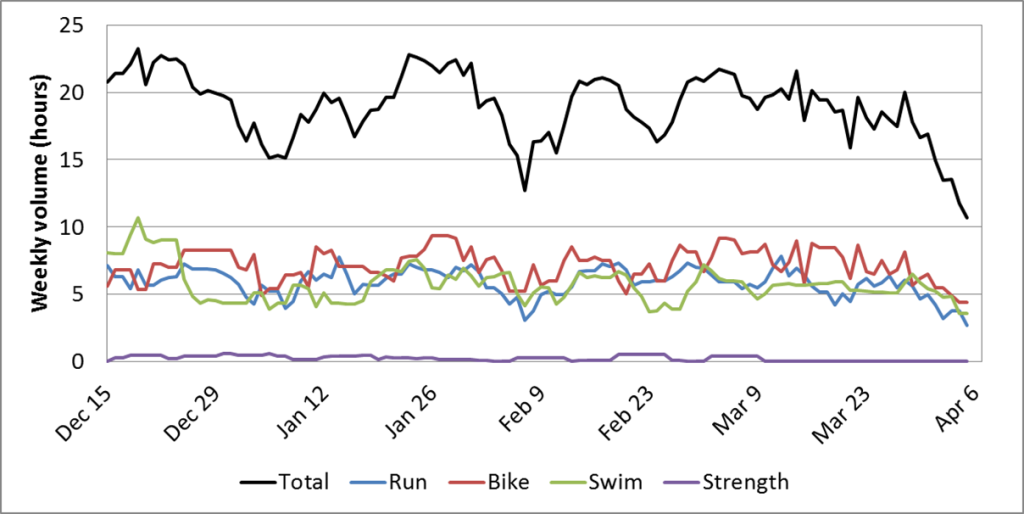
Bike Training
(This section assumes some familiarity with power training concepts: FTP, power zones/levels, TSS)
My approach to bike training was very simple, even simplistic, and followed a few basic principles:
- maximize bike training load (without compromising the quality of swim or run training)
- focus on 70.3 race-specific intensities (Zone 3/tempo to Zone 4/threshold)
- two types of workouts: hard or easy, never sort of hard (avoid upper Zone 2/endurance-lower Zone 3/tempo) or really easy (no “active recovery” rides)
- no scheduled recovery time, take recovery on an as needed basis
I did a lot of work in the upper Z3/tempo to lower Z4/threshold range, an approach often referred to as “sweet spot training” because it produces relatively large training effects without generating a ton of fatigue. I found that I was able to absorb a lot of training load at this intensity.
I made the questionable decision that the high physical and mental toll of training above threshold outweighed its benefits. I took the rather extreme approach of almost completely avoiding it. In fact, I did virtually no intervals under 10 minutes in duration.
I repeated a similar 7 day training cycle almost every week. A typical week featured 4-5 bike sessions:
- a 1.5 hour workout with threshold/Z4 intervals, often 2×20 minutes at 90-98% FTP. This workout is deeply entrenched in triathlon training lore, but there’s really nothing special about it. I just find it to be a simple, manageable, replicable and race-specific benchmark workout.
- a 3 hour long ride with 1-2 hours of intervals from upper Z3-lower Z4. I considered this a key session for 70.3 training. It was usually a pretty devastating workout, often approaching 200 TSS.
- 2-3 easier rides of 1-1.5 hours at steady mid-Z2/endurance power
I had an outline of what I wanted to accomplish in each workout, but I wouldn’t finalize the workout until after my warm-up. I never pre-programmed my CompuTrainer workouts, instead using the manual controller to dial in the effort based on how I felt each day. These micro-adjustments in my training were crucial, because some days ±10 W makes all the difference.
Details of every single workout in the 16 weeks prior to the race are below. I also upload all my power files to my Strava account.
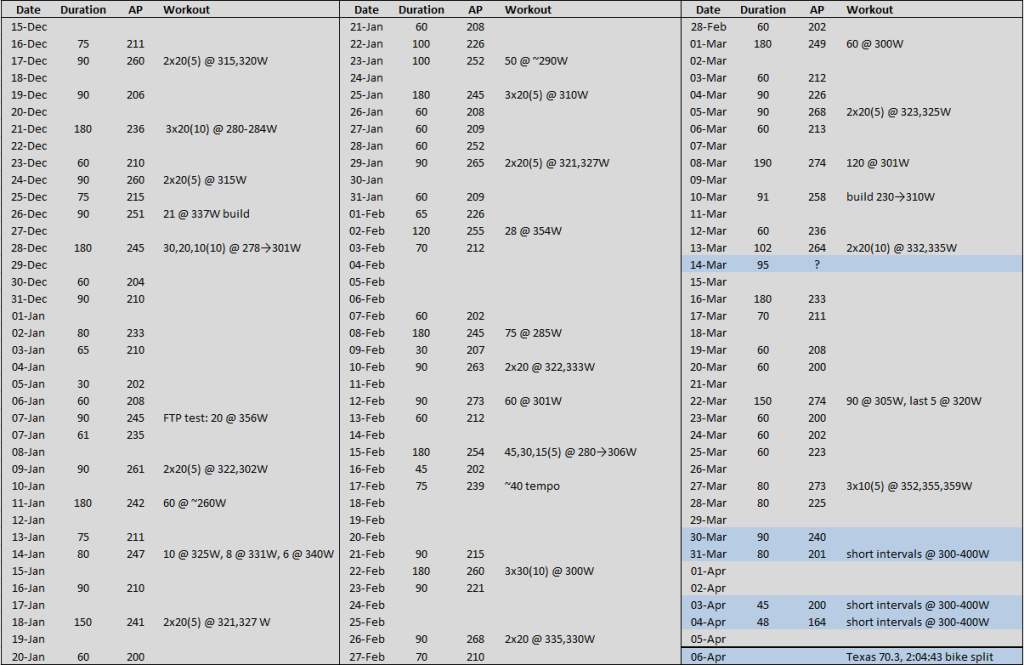
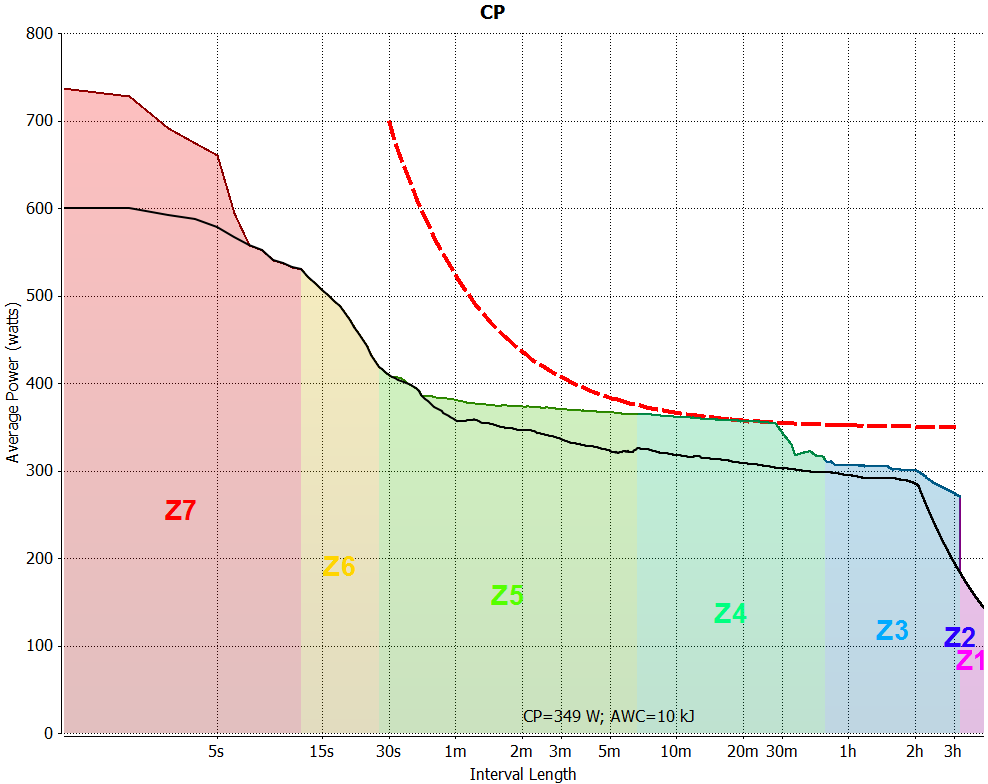
A Note on Race Weight
Losing weight is another common piece of advice for aspiring cyclists. I’ll be blunt: the majority of age group triathletes will get faster by shedding pounds. But my experience was the opposite. I raced Texas 70.3 at ~152 lbs at just under 6′ tall, a full 10-15 lbs heavier than 2012 and 5-7 lbs heavier than 2013. Coming from a BMI of <19 to ~21 put me more in line with the world’s best long course triathletes and cycling time trialists. But beyond the numbers, my body was clearly much happier with the extra weight (read more: Fatter & Faster? Finding My Racing Weight).
Remember that race weight isn’t your lightest weight, it’s your fastest weight. It can only be determined through trial and error, not with a scale, and it’s not necessarily a stationary target.

What I would do differently
I identified a few shortcomings in my training. Here are some key changes I will make in the future.
- Vary the stimulus. My FTP grew rapidly on a steady diet of sub-threshold cycling, but began to plateau weeks before my race. I doubt that I would continue to see gains with that approach without significantly increasing training load. To avoid stagnation, I will now experiment with a training block focusing on higher volume endurance rides coupled with shorter, higher intensity intervals (upper Z4-Z5).
- Add intervals above threshold. My first experience with pro triathlon cycling showed that it is unlike the relatively steady state effort of age group racing. I was ill-prepared to cope with the many 400-600 W surges required to pass, hold my position through turns, and respond to pace changes. Those unfamiliar super-threshold efforts on the bike may have prevented me from running to my potential.
- Schedule recovery time. This was my most consistent period of training ever, but I still suffered unpredictable bouts of extreme fatigue that would physically and psychologically derail me for a few days every month. I suspect that my sporadic, reactive approach to recovery is to blame. I will work on building regular recovery time into my training program.
